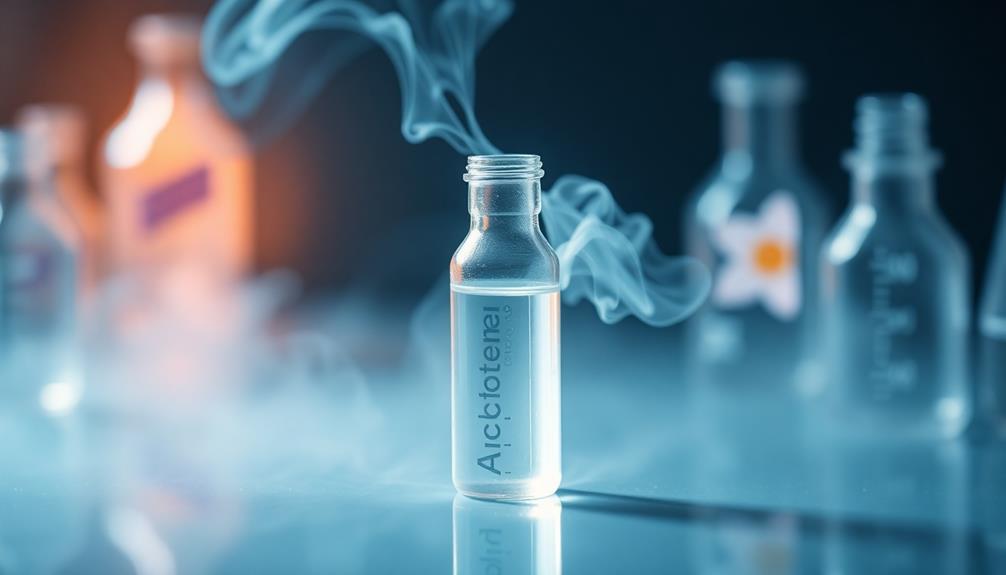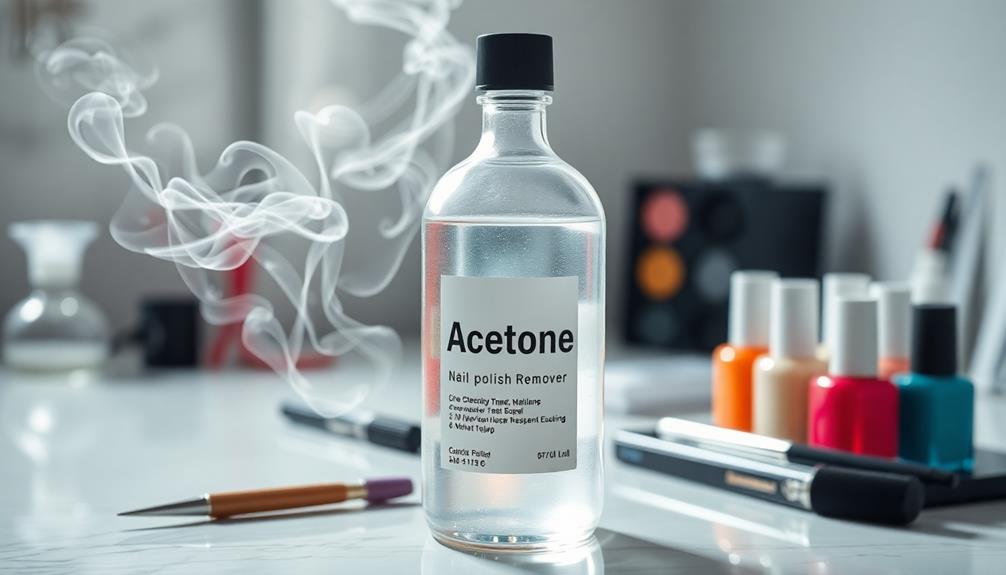Acetone smells sweet and sharp, like overripe fruit or that familiar scent of nail polish remover. You can usually spot it in nail salons or homes using cleaning products. The smell is really strong, so it fills the air quickly! This sharp scent comes from a chemical called acetone, which can also appear in your breath if your body is breaking down fat for energy. Just remember, while it might remind you of beauty routines, too much acetone can be irritating. If you're curious about how this scent fits into different settings, there's even more to discover!
Key Takeaways
- Acetone has a sweet, sharp odor reminiscent of nail polish remover or overripe fruit.
- The scent is easily detectable and can fill the air quickly, especially in poorly ventilated areas.
- It is a colorless, volatile liquid produced naturally and synthetically, classified as a ketone.
- Commonly encountered in nail salons, industrial settings, and as a byproduct of ketosis in the human body.
- Acetone's strong scent can trigger nostalgic memories but may also cause respiratory irritation if inhaled excessively.
Introduction

Acetone, often found in nail polish remover, has a distinct and recognizable scent that many describe as sweet and fruity. When you catch a whiff of this fruity scent, it's usually because acetone is present, either in your favorite beauty product or in the human body.
Acetone is a type of ketone, a chemical compound produced when the body breaks down fat for energy. Sometimes, when someone has high blood sugar or a condition called diabetic ketoacidosis, the body produces too many ketones. This can lead to a sweet odor on their breath, which is a sign that they need to monitor their health carefully.
The smell of acetone is sharp and can be overwhelming in poorly ventilated spaces, especially when used as a solvent. Prolonged exposure to the strong, pungent odor can cause dizziness or headaches in some individuals. In fact, many people compare the scent of acetone with what meth smells like cooking, which is often described as a sickly sweet yet chemical stench. Proper ventilation and protective measures are essential when working with such substances to avoid discomfort or health risks.
It's fascinating how a simple scent can tell us so much about what's happening inside the body! By recognizing this sweet odor, you can learn to associate it with important health signals.
Description of the Smell

When you encounter the scent of acetone, you're struck by its distinct sweetness that often evokes memories of nail polish remover or even the aroma of overripe fruit. This smell is quite unique and fruity, making it easy to identify. You might notice it even in low concentrations, which means it can fill the air around you without being overwhelming.
Acetone's odor is sweet and sharp, a result of its volatile nature. It evaporates quickly, releasing its smell into the environment. You might catch a whiff of it in places like nail salons or when people use products containing acetone. It's fascinating how a small amount can create such a strong scent!
In some medical situations, acetone breath becomes a topic of interest. When someone has high levels of ketones, their breath can smell sweet and fruity, serving as a diagnostic indicator for conditions like diabetic ketoacidosis.
Source and Composition

The source of acetone lies in both natural and synthetic processes. You might recognize acetone by its distinct smell, often described as sweet or fruity, similar to nail polish remover. This unique odor comes from its chemical composition, C3H6O, classifying it as a ketone. Ketones are known for their special smells, and acetone is no exception!
Acetone is a colorless and volatile liquid, which means it easily evaporates and disperses its odor in the air. This property makes it common in many household products, like solvents and cleaning agents. You might catch a whiff while using nail polish remover or cleaning supplies.
Interestingly, acetone can also be found in the human body! During a process called ketosis, which happens when your body breaks down fats for energy, it produces acetone. This can result in a fruity odor on your breath, especially in cases like diabetic ketoacidosis.
Typical Scenarios or Environments

You might encounter acetone's distinctive smell in various everyday situations. One of the most common places is when you use nail polish remover. That sweet, fruity smell is a sign of acetone, and it can fill the air quickly.
In industrial environments, you might notice it too, especially in places with cleaning agents and solvents. If the space isn't well-ventilated, the smell can become quite strong. This can be particularly noticeable in areas where machinery operates, adding to the mix of odors. For example, many workers who handle equipment maintenance are familiar with what coolant smells like—it’s a distinct, somewhat sweet but chemical aroma that lingers around engines and other industrial systems. Prolonged exposure in poorly ventilated spaces can lead to discomfort or even potential health risks if safety measures aren’t taken seriously.
You may also catch a whiff of acetone in medical settings. Doctors often monitor ketones in diabetic patients, and elevated levels can lead to a fruity breath smell. It's fascinating how your body's metabolic process can create such scents!
If you're on a ketogenic diet, you'll find that the fruity smell of acetone can show up in your breath as your body breaks down fat for energy.
Lastly, laboratories and workshops that use acrylics or resins often use acetone as a cleaning agent, making its smell a common encounter there too. Each of these scenarios highlights how acetone, with its unique scent, plays a role in our daily lives!
Emotional or Cultural Associations

Although acetone's scent is often linked to everyday products, it also carries emotional and cultural weight that can shape our perceptions. The sweet, fruity smell of acetone reminds many of beauty routines, like nail polish applications or fun arts and crafts. These memories can spark feelings of nostalgia, transporting you back to moments spent with friends or family.
In cultural contexts, acetone symbolizes creativity and self-expression, especially in the arts. Artists often use acetone as a solvent, making it a common part of their creative process. However, the smell can also trigger emotional responses that aren't always pleasant. If you've been in a poorly ventilated space filled with acetone fumes, those memories might bring anxiety or discomfort.
Interestingly, acetone's scent sometimes appears in stories and films, representing danger or a chemical threat, adding drama to the narrative. This dual nature of acetone—both inspiring and cautionary—highlights its impact on our emotions.
Health or Safety Considerations

Acetone's sweet, fruity scent can evoke memories of creativity and fun, but it's important to recognize the health and safety considerations that come with its use. Inhaling acetone vapors can lead to respiratory irritation, dizziness, and headaches. So, when you're using acetone-based products, make sure you're in a well-ventilated space.
If you're working with acetone for a long time, it's wise to wear personal protective equipment, like gloves and masks, to prevent skin irritation and dermatitis. This way, you can enjoy your projects without worries!
For those with diabetes, be aware that a fruity smell on your breath might signal high ketone levels. This could mean diabetic ketoacidosis, which requires immediate medical attention.
Also, remember that acetone is a flammable substance. Its flash point is quite low, so always store it away from heat sources.
Safety first! By keeping these health considerations in mind, you can enjoy the benefits of acetone while minimizing risks. Always prioritize your well-being, and you'll be safe while creating and exploring!
Final Thoughts

Understanding the smell of acetone is crucial for both safety and awareness. Acetone has a distinct, sweet, fruity odor that many people recognize, like the scent of nail polish remover. When you notice this smell, it might be a sign of something more serious, especially in people with diabetic ketoacidosis (DKA). In DKA, the body produces extra ketones, leading to a fruity breath that signals metabolic distress.
If you're following a ketogenic diet, your body metabolizes fat, and that can also create ketones, which might give off that same acetone smell. This fruity odor serves as a handy diagnostic indicator for healthcare professionals. They can quickly assess metabolic conditions, particularly in diabetic patients.
While acetone is naturally found in the body, strong odors can indicate overexposure, often from industrial settings. In such cases, it's important to get help right away.
Frequently Asked Questions
What Is the Scent of Acetone?
When you encounter acetone, you'll notice a sharp, sweet, and fruity scent. It often reminds you of nail polish remover and can even evoke thoughts of overripe fruit due to its chemical composition.
What Does Acetone Breath Smell Like?
Acetone breath has a sweet, fruity odor that might remind you of nail polish remover. If you notice this scent, it could indicate elevated ketone levels, especially if you're experiencing other concerning symptoms.
What Does Pure Acetone Smell Like?
When you encounter pure acetone, you'll notice its distinct, sweet, and fruity odor. It's easily recognizable and reminiscent of nail polish remover, thanks to its volatile nature and unique chemical structure.
What Does Smelling Acetone Do to You?
Smelling acetone can lead to headaches, dizziness, and confusion. If you're exposed for too long, you might experience respiratory irritation and gastrointestinal discomfort. It's essential to ensure proper ventilation to avoid these harmful effects.









